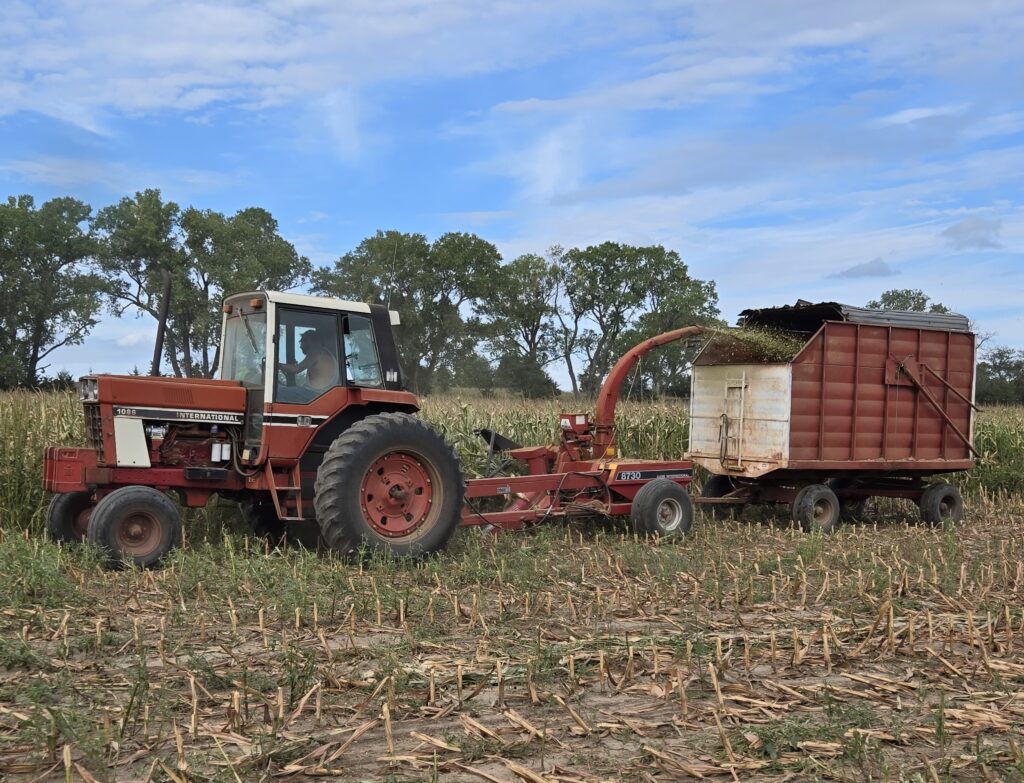
Kenning Farm Operation now includes five generations with the original farmstead being well over 100 years old. The original farmstead south of Endicott was started by my great-grandfather, PA Carrico, according to Dennis Kenning, fourth generation farmer. That farm was called Rocky Hollow Farm because the hillsides were covered with sandstone rock.
“In fact we lived in my great-grandfather’s homestead house made of the sandstone rock. In that area most of the homesteads were constructed with the sandstone rock,” Kenning said. “Later we moved in another house because the sandstone walls were collapsing. On the original homestead, I have been trying to preserve the old barn.”
Kenning continued, “You don’t really see many of the big barns and it has a sandstone foundation. The barn included six stalls for the draft horses, 10 milking stanchions, a granary, cattle shed, and a hay loft. The hay loft has a large hinged door at the peak to accommodate lose hay through the use of hay slings, with a trolley to move hay across the barn loft.”
Currently the family use the barn for calving out cows during the winter months and use it for working calfs. Looking through the history of the farm, Kenning’s great-grandfather had to mortgage the farm a number of times because of the tuff times.
“Through generations many of struggles are not much different, with low market prices, high input costs, borrowing money and drought. It doesn’t seem to matter if it’s 1925 or 2025, the farm life can be pretty tuff. It’s not for everyone.”
Today the operation includes beans, corn, hay, and a cow/calf herd. “We also do a fair amount of custom farming by putting up hay and harvesting crops.”
Kenning said, “my goal was to retire from teaching Agriculture Education with a 40 to 50 head cow herd. My son has kind of taken the cow/calf operation to a whole another level.”
Raising corn is kind of an important part of the operation and it has been a good dry land crop. They run our cows on corn stocks and bale stocks as filler in the feed ration, plus use some corn stocks for bedding. They buy distillers by-product from the corn ethanol plants and use corn in our feed rations.
“For the most part all of our equipment is purchased used due to the high price of new machinery. So it seems like we are always repairing or fixing equipment and those parts are expensive and availability can sometimes be a problem. Last year I was putting hay down when the fan went through the radiator,” Kenning said.
The replacement parts were around $8,000.
“At the same time, we simply cannot pencil out new equipment for our operation. A new combine can exceed a million dollars, and that may not have all the bells and whistles. Another problem for our operation is that we need a great deal of machinery for cropland, hay ground, and feeding equipment. We use no-till with our crops and use cover crops, when appropriate.”
In recent times, cattle prices have been good and they are an important part of the operation. However, all of those expenses to produce beef have been higher with increased cost of feed, taxes, medications, transportation, and other inputs. Raising cattle can take a great deal of labor and when you have livestock you’re on call 7/24, for 365 days of the year. And there is always those times when you have to pull a calf at 2:00 am during a snow storm, you got to be there. “It’s your livelihood,” Kenning said.
“We use technology in our operation when we see a real benefit and if it helps our bottom line. We plant using GPS for guidance with auto steer and row unit shut offs on the planting units. This year we used GPS tags on most of our herd bulls. These tags provide us their location, number of mounting and it has a good record keeping system. For our operation technology has got to be affordable with a real benefit. Technology is just one area of agriculture that just keeps growing, anymore if you can dream it they will make it.”
Kenning said, “Sometimes I wonder why I’m farming with long hours, hard work, poor grain prices, and at times low rainfall. I guess it gets in your blood and you can’t let it go. And if you make a bad decision, you’re the one that has to live with it. On the flip side in farming: you’re your own boss, you set your own hours, you are in charge and work is not going to get done if you’re sitting still. Sometimes the rewards come in different ways like saving a baby calf, raising a good crop, or making a wise decision. A lot of people don’t realize that most farmers only get one crop per year. I’ve learned to never brag or boast that will nip you ever time”.
